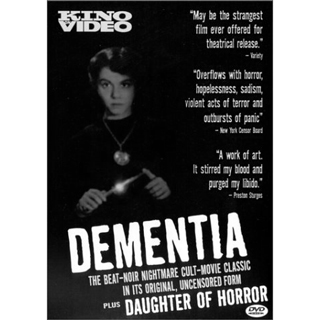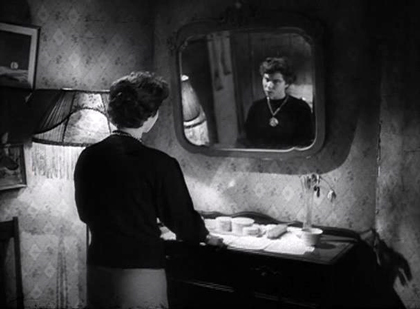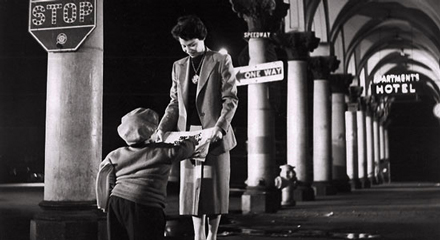| Release List | Reviews | Price Search | Shop | Newsletter | Forum | DVD Giveaways | Blu-Ray/ HD DVD | Advertise |
| Reviews & Columns |
|
Reviews DVD TV on DVD Blu-ray International DVDs Theatrical Reviews by Studio Video Games Features Collector Series DVDs Easter Egg Database Interviews DVD Talk TV DVD Talk Radio Feature Articles Columns Anime Talk DVD Savant HD Talk Horror DVDs Silent DVD
|
DVD Talk Forum |
|
|
| Resources |
|
DVD Price Search Customer Service #'s RCE Info Links |
|
Columns
|
 |
Dementia &
|

|
Dementia / Daughter of Horror Kino Video 1953/'57 / B&W / 1:37 flat full frame / Street Date October 17, 2000 / 29.95 Starring Adrienne Barrett, Bruno Ve Sota, Ben Roseman, Angelo Rossitto Cinematography William C. Thompson Production Designer Ben Roseman Film Editor Joseph Gluck A.C.E. Original Music George Antheil Musical director Ernest Gold Featured Vocal Marni Nixon New Concepts in Modern Sounds Shorty Rogers and his Giants Associate Producers Bruno Ve Sota and Ben Roseman Written, Produced and Directed by John J. Parker |
Well, here's another Savant milestone. Just two months ago an associate (Darren Gross) was thinking of rare films to find and restore for DVD (we dream big here in the City of the Angels) and I mentioned Daughter of Horror, a title I was certain would never surface. Just to prove that it existed, I had saved my Audio Brandon 16mm catalog from 1972 when I showed it at UCLA. When Alain Silver was releasing George Antheil original recordings on CD in the late 80's, I told him about Daughter of Horror and its wall-to-wall weirdo Antheil score. My associate editor and pal Todd Stribich bought a Sinister Cinema tape which was so dark and dank, it was like trying to watch a movie down a cow's throat. But the terrifying voice was there ... in the dark ... the demon voice:
In the pulsing, throbbing, world of the INSANE MIND
Where only nightmares are real.
Kino Video's new double bill of Dementia / Daughter of Horror is a movie history lesson in a box. After being written up in the Incredibly Strange Movies book it still remained a film about which little was known. It bears no director or actor credits, so one had to take it on faith that somebody named John Parker was the director. The only other trace it had left in movie history was a snippet or two that showed up in Jack H. Harris' The Blob, both on the screen of the amoeba-infested movie theater and on a garish poster seen for a split second as the terrified teens of Valley Forge run for their brylcreemed lives. The poster read Daughter of Horror ... it's a clue, kids! Forrest Ackerman once ran a mystery poster in his Famous Monsters of Filmland magazine, a reproduction of this poster for some phoney film called Daughter of Horror ... a fake title if we ever heard one. Even Forry was thrown by this one .. in his next issue he admitted that he didn't know if it were a real movie or not!

Dementia is a real movie made independently by a cineaesthete from the Northwest who lived high and filmed wide on his mother's money. And it's no ordinary lowbudget movie. Filmed professionally on Hollywood stages and photographed by Ed Wood regular William C. Thompson (although claims have been made that film students shot most of it) Dementia has no dialogue whatsoever and is really a silent movie with added music and sound effects, in both the spirit and technique of Dreyer's great Vampyr... only even more twisted toward German Expressionism. Add to that an artsy/slightly pretentious dab of Maya Deren / Curtis Harrington-style experimental film atmosphere and you just about have it. Dementia never looks incompetent (Bride of the Monster), naive (Carnival of Souls) or commercial (The Mask). In fact, it's like no other movie ever made, really.
Synopsis:
The Gamin (Adrienne Barrett) wakens on a dark night in a city of the Damned. Dressed like a beat chick from pre- rock'n roll days (except for an attention-getting medallion), she takes a switchblade from her dresser and starts out on the town. She witnesses an arrest for wife-beating, sees some winos and is accosted by a midget newsboy (Angelo Rossito) who hawks a paper with a prophetic headline about a murder. A pimp finally gets the Gamin's attention and sets her up with a porcine Rich Man (Bruno ve Sota) in a chaufeurred black car. He takes her to a series of nightclubs, and then to his highrise apartment in a building with an enormous staircase. There she watches him eat a greasy meal of chicken. When he makes advances, the Gamin defends herself ... or is she attacking? This is no ordinary night, for from this moment on events and perceptions no longer have even the pretense of reality ... as the Gamin enters a nightmare of murder and mutilation.
The essential feature on Kino Video's DVD of Dementia / Daughter of Horror is its illustrated essay on the making of the film that for the first time clears up the mystery of John Parker. He actually did solicit Preston Sturges' support for the film. He did submit the movie over ten times to the New York censors between 1953 and 1955, only to be refused a license for exhibition due to its horror content. Their gripe sheet includes just about every forbidden item in the Code: Although only a fairly grim dismemberment is depicted the implications of the film cover prostitution, pimping, police corruption, adultery, incest (maybe) and heroin addiction. The censors demanded the deletion of practically every event in the film. Commercially, Dementia went exactly nowhere. The DVD shows some rare photos of the one forlorn art-house it played in New York, double-billed with a short subject on Picasso, for cripe's sake.

The DVD places the short theatrical career of the Dementia re-edit, Daughter of Horror, in 1957 and not 1955. The titles and credits were mangled and a ghostly (barely visible) face was added up front to motivate the addition of a narrator-demon. He illustrates the proceedings with baleful running commentary and curses from beyond the grave (Several are scattered through this review ... for those who look very carefully). The man behind the voice is the pre-boozy baritone of none other than Ed McMahon, doing a moritferous read that would make Zacherly, See-mour and any other horror host cower in fear. In a dream sequence early on (cleverly left out of the synopsis above) the Gamin shows up at a graveyard. There she is met by the narrator-demon, and taken on a tour of her ruined, sordid adolescence - which plays out in the graveyard itself, among the tombstones! :
In 1989 or so I showed the bovine-throat Sinister Cinema version of Daughter of Horror to my usually skeptical and unflappable editor friend Steve Nielson. He instantly declared it the best movie he'd seen that year. The story is not only told cinematically, the film switches gears between realism and surrealism on the turn of a dime. Besides Anthiel's creepy music there are several minutes of hip jazz from Shorty Rogers in a basement nightclub at the edge of the world. Here's where the hopheads hang out and the oily police detective (who looks suspiciously like the Gamin's father) takes his bribes.
Since our Gamin is kind of a beat type herself this is a horror film in the vein of Jack Kerouac. Several of its exteriors are filmed in the same Venice, California collonade block made famous by the later Touch of Evil, although Jim Ursini recognized the massive staircase as belonging to an L.A. hotel right off MacArthur Park. The last recognizable element is the voice of a young Marni Nixon, who wails throughout the Antheil score practically non-stop. Except for some laughter, gunshots, screams and a little be-bop jazz it goes on uninterrupted for an hour. It was seemingly lampooned in a short film in an old Saturday Night Live. In that skit a female motorist is terrorized by wailing, nervous singing that is finally revealed to originate from a woman shrieking into a microphone on the floor of her apartment. Very far out stuff ... it might have been a Ben Stiller movie.
This last bit of narration can be heard in The Blob, which uses several seconds of one of the terror high points of Daughter of Horror. Jack H. Harris was a partner in the company that bought the rights to Dementia and did the dubbing retread. If you listen carefully you'll notice that the music level shifts just before and after every narration line, tipping this editor off to the fact that Harris and his cheapskate pals in "Exploitation Productions Incorporated" simply duped the track, added the voiceover and spliced the optical negative right back in without remixing the whole feature. They did, however, find the time to Ix-Nay the Edit-Cray for Turner, along with credits for the cast. What were they afraid of?

Savant had always feared that Dementia had been destroyed to make Daughter of Horror 1 but this smart DVD contains both versions. Dementia is said to be taken from the original negative, and Daughter from a print. Both look exceptionally good, with the original having the edge on quality, although it's not completely free of speckles either. The animated starfield opening makes it seem like a "cosmic despair" version of It's A Wonderful Life. There's a miserable trailer you might look at once; the aforementioned text-and-photos chronicle of this obscure gem is the hot extra. Besides the Ed McMahon voiceover (which I'm afraid I still miss in Dementia), Daughter does have one of the required censor cuts.
Some of you have already found to your displeasure that when Savant falls off his computer chair praising films like Black Sunday to the skies, there's a whole lotta fan enthusiasm afoot. If you don't care for mini-budgeted, dank and creepy, old and eeky horror films that crawl out from under rocks, well, Dementia /Daughter of Horror might not be your glass of tea. Finally seeing it in a version that doesn't require night-vision goggles was truly a thrill - maybe some films must be coveted for 30 years, to work up an appropriate lack of perspective!
Note: For those who elect to watch only Dementia I've included the entire text of Daughter of Horror's narration, a prose poem worthy of Edgar Allan. It's best recited in the shower, at full bellowing volume, until the wife threatens to leave. First person to write music for these lyrics gets a Pulitzer. 2
On a scale of Excellent, Good, Fair, and Poor,
Dementia / Daughter of Horror rates:
Movie: Excellent
Video: Very Good
Sound: Very Good
Supplements: "Dementia: A Case Study", an illustrated essay on the making of the film; trailer & pressbook, stills galleries.
Packaging: Keep case
Reviewed: October 26, 2000
Footnotes:
1. It happens more often than you'd think. Imagine the surprise of Steven Spielberg when he went to do his director's cut of Close Encounters of the Third Kind, only to discover that the original 1977 negative had been massacred to create the Special Edition of 1980, with the various missing parts nowhere to be found. Who's responsible: Spielberg, Columbia, or Jiminy Cricket?
Return
2.
You - you out there. Do you know what HORROR is?
Smug. Confident. Sure. Because you are sane.
Do you know what madness is or how it strikes?
Have you seen the demons that surge through the corridors of the crazed mind?
Do you know that in the world of the insane
You will find a kind of truth more terrifying than fiction?
A truth that will SHOCK you?
Come with me into the tormented, haunted, half - lit night of the INSANE.
This is my world. Let me lead you into it.
Let me take you into the mind of a woman who is MAD.
You may not recognize some things in this world
And the faces will look strange to you
For this is a place where there is NO love, NO hope
In the pulsing, throbbing, world of the INSANE MIND
Where only nightmares are real.
Nightmares of the DAUGHTER OF HORROR.
The pulse of the neon lights, like a hammer at your brain
Tormenting you, haunting you
Forcing you to think, forcing you to remember your guilt, your HORROR.
Forcing you to go back, back, back into the TERROR that you are trying to forget
Back through the mists of time
Into the graveyard where your secret lies buried from the world.
Yes, I am here. The DEMON that possesses your soul.
Wait a bit. I have so much to show you. So much that you are afraid to see.
Come, let me take you by the arm and show you the bed of EVIL you sprang from.
Let me take you back to when you were a little girl. Let me show you - your father.
Let me show you - your mother.
Marked! Marked forever, DAUGHTER OF HORROR.
Guilty. Guilty. Guilty. Mad with guilt and the DEVILS that have taken possession.
There. There it is. The body of your latest victim.
And around it the GHOULS of insanity. The imaginary figures real only to you.
The pendant! The clue to your guilt!
The GHOULS know. They know you did it. But they can't hurt you.
You've got to get it. You've got to take it out of his hand.
Go ahead, the GHOULS won't hurt you!
Run, DAUGHTER OF HORROR, run from your crime.
But behind you the policeman with the face of your father,
The face of your first victim.
Pursuing you relentlessly through your haunted dreams
Hunting you mercilessly through the twisted corridors of your TORTURED mind.
The HORROR that will track you down!
The HORROR that will destroy you!
Run. Run. Run. Guilty. Guilty. GUILTY!
Nowhere to run. Nowhere to hide. If you could only wipe out the CURSE of your guilty past.
If you could only become somebody else before it is too late.
Escape into a world of your kind of people.
Safe. Safe at last.
Yes, you are safe in another hallucination of your CRAZED mind.
Safe. In a drug dream of forgetfulness.
Yes, he's seen you. And you're trapped.
The handcuffs are waiting for your wrists.
Look. Look. It's your latest victim.
Now everybody knows. There is NO escape.
Look around your neck. The pendant, for everybody to see.
Now all the images of horror, the DEMONS of
your mind crowd in on you to DESTROY you!
Only a dream. A dream of MADNESS on a dark night.
Or was it? Was it ONLY a dream?
THE END made in Hollywood U.S.A.
Return
Review Staff | About DVD Talk | Newsletter Subscribe | Join DVD Talk Forum
Copyright © DVDTalk.com All rights reserved | Privacy Policy | Terms of Use
|
| Release List | Reviews | Price Search | Shop | SUBSCRIBE | Forum | DVD Giveaways | Blu-Ray/ HD DVD | Advertise |





